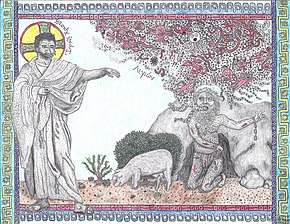Legion (demons)
Legion is a demon or group of demons, particularly those in two of three versions of the exorcism of the Gerasene demoniac, an account in the New Testament of an incident in which Jesus performs an exorcism.

Development of the story

The earliest version of this story exists in the Gospel of Mark, described as taking place in "the country of the Gerasenes". Jesus encounters a possessed man and calls on the demon to emerge, demanding to know its name – an important element of traditional exorcism practice.[1] He finds the man is possessed by a multitude of demons who give the collective name of "Legion". Fearing that Jesus will drive them out of the world and into the abyss, they beg him instead to send them into a herd of pigs, which he does. The pigs then rush into the sea and are drowned (Mark 5:1–5:13).
This story is also in the other two Synoptic Gospels. The Gospel of Luke shortens the story but retains most of the details including the name (Luke 8:26–8:33). The Gospel of Matthew shortens it more dramatically, changes the possessed man to two men (a particular stylistic device of this writer) and changes the location to "the country of the Gadarenes". This is probably because the author was aware that Gerasa is actually around 50 km away from the Sea of Galilee (although Gadara is still 10 km distant). In this version, the demons are unnamed [2][3] (Matthew 8:28–8:32).
Cultural background
According to Michael Willett Newheart, professor of New Testament Language and Literature at the Howard University School of Divinity (2004), the author of the Gospel of Mark could well have expected readers to associate the name "Legion" with the Roman military formation, active in the area at the time (around 70 AD).[4] The intention may be to show that Jesus is stronger than the occupying force of the Romans.[5] Seyoon Kim, however, points out that the Latin legio was commonly used as a loan word in Hebrew and Aramaic to indicate a large number.[6]
See also
References
- Keener 1999, p. 282.
- Senior 1996, p. 84.
- Boring 2006, p. 148-149.
- Newheart 2004, p. 44-45.
- Blount & Charles 2002, p. 77-78.
- Kim 2008, p. 118-119.
Further reading
- Blount, Brian K.; Charles, Gary W. (2002). Preaching Mark in two voices (1st ed.). Louisville, Ky.: Westminster John Knox Press. pp. 77–78. ISBN 9780664223939.CS1 maint: ref=harv (link)
- Boring, M. Eugene (2006). Mark: A Commentary. Presbyterian Publishing Corp. ISBN 978-0-664-22107-2.CS1 maint: ref=harv (link)
- Keener, Craig S. (1999). A Commentary on the Gospel of Matthew. Wm. B. Eerdmans Publishing. ISBN 978-0-8028-3821-6.CS1 maint: ref=harv (link)
- Kim, Seyoon (7 October 2008). Christ and Caesar: The Gospel and the Roman Empire in the Writings of Paul and Luke. Wm. B. Eerdmans Publishing. ISBN 978-0-8028-6008-8.CS1 maint: ref=harv (link)
- Newheart, Michael Willett (2004). My name is Legion: the story and soul of the Gerasene demoniac. Collegeville, MN: Liturgical Press. ISBN 0-8146-5885-7. OCLC 55066538.CS1 maint: ref=harv (link)
- Senior, Donald (1996). What are They Saying about Matthew?. Paulist Press. ISBN 978-0-8091-3624-7.CS1 maint: ref=harv (link)
External links
- EarlyChristianWritings.com Gospel of Mark, see discussion at bottom of page